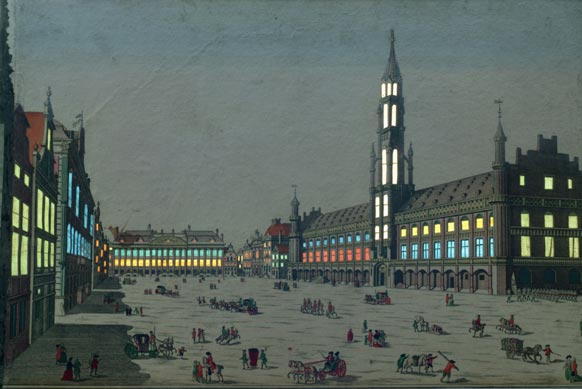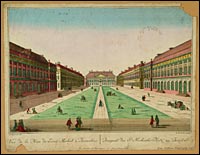People did not travel much in the XVIIIth century. News was passed on essentially by word of mouth. One heard about other cities, some of them fabulous, of major political events, but one never saw any images. The optical views opened a window to the world. They allowed people to take on imaginary journeys and to dream when discovering colored views of cities, monuments, landscapes and events. In a way they played the part taken over by television today. The nearly sixty views presented here were chosen among the 400 optical views of the collection given to the Musées royaux d’Art et d’Histoire in 1943 by Charles Lefebure, and completed by various loans from the Print Cabinet of the Bibliothèque royale, the City Archives and the Musée du Cinéma of Brussels, of the Stadsarchief and of the Stadsmuseum De Bijloke in Ghent, the French Cinémathèque of Paris and private collectors.
Discover far-away cities, or the eruption of the Vesuvius
The optical view was to give a perspective effect that was increased when placed in a box designed to look at it. Zogroscopes and optical boxes are close to its derivative, the panoptic panorama, a toy that was the rage during the second half of the XIXth century. Some of these devices were lit behind the view, in such a way that the light went through perforations and colored papers to create an extraordinary effect of illumination. Who looked at those views? Everyone! Those who had the means bought them and collected them. The optical box, sometimes a real work of art in woodwork, was part of the equipment that was indispensable in any popular salon. Those who lacked the means to buy themselves one would await a traveling demonstrator to come by and, for a few cents, with their eye stuck to the lens, would discover faraway cities or shudder as they saw the eruption of the Vesuvius….
Buildings now gone and the daily life of the inhabitants
Augsbourg, Zanna in Brussels or Basset in Paris, one finds a series dedicated to the territory of modern Belgium, to Brussels in particular, a city that underwent a great number of renovations and constructions towards the middle of the XVIIIth century under Charles of Lorraine. One can discover the place Saint-Michel - the current place des Martyrs -, and the Royale place, both very characteristic of the times. The castle of Scoonenberg, today the palace of Laeken, is represented from all its angles. The new park of Brussels was also affected by the fashion. Eleven different cities, such as Antwerp, Liège, Namur, Tournai, Termonde, are illustrated with monuments or views that at times are realistic, at others completely imaginary. Ghent is the object of a true report with a series of 12 prints that sketch the markets, the squares and the boats on the Lys and Coupure rivers. Current photographs, sometimes of details, show to what point some of these views are realistic or are true witnesses of the architecture at a given moment in its history. One discovers certain buildings that no longer exist, as well as the daily life of the inhabitants, the means of transportation, the customs. Carriages, strollers and onlookers as well as quacks bring these squares to life. We can see a demonstrator of optical views on the place du marché aux Grains in Ghent or a vendor of porcelain in Tournai.
The arrival of photography
The search for rendering the perspective also led to the creation of small, cut out theaters launched by Martin Engelbrecht in 1719 at Augsbourg, and that of the panoramas. All of these documents, optical views, cut out theaters and panoramas are actually the 3-D representation of the time. The arrival of photography in 1839 would give Carlo Ponti, in 1862, the idea of replacing prints by a photograph and the optical box by the megalethoscope. This last invention would be the swan’s song of the optical boxes since photography would perfect an extraordinary process that rendered relief and perspective: stereoscopy. The dream became a reality!
For reasons of preservation, the views presented will be changed in the middle of the month of March 2007.
Illustration: The place Saint Michel in Brussels, Probst, Augsburg 1785
PUBLICATION
Exhibition catalogue: Claudine Deltour La Belgique en vues d’optique – XVIIIe – XIXe siècles French/Dutch 21, 5 x 14 cm, 80 p. published by Musées royaux d’Art et d’Histoire 7 €
A book by Pierre Levie Montreurs et vues d’optique 220 p. 200 ill., will be published before the end of the year by Éditions Sofidoc and available at the Museum bookstore at € 39, postage free for subscriptions.
Information :Sofidoc, rue Colonel Bourg 46 1030 Bruxelles, tél : 02 705 09 90, fax : 02 705 17 44 ; e-mail : info@sofidoc.be
|
ROYAL MUSEUMS OF ART AND HISTORY
Parc du Cinquantenaire 10, 1000 BRUSSELS
INFORMATION:
Tél: 02 741 72 11, Fax: 02 733 77 35
E-mail : info@mrah.be Site: www.mrah.be Guided visits : 02 741 72 15
OPENING HOURS:
From 9,30am to 5pm, Tuesday to Friday (Be careful: cash desks close at 4pm). From 10am to 5pm Saturday, Sunday and Holidays.
Closed on Monday, December 25th 2006 and January 1st., May 1st, November 1st and 11, and December 25th 2007. Late opening till 10pm on Thirsdays 30/11, 25/01, 22/02, 29/03 et 26/04.
ADMISSION FEES:
Until 31/12/2006 Full price: €4. Concessions: €3 and € 1,5 From january 2 2007 € 5, € 4 and € 1,50 (i.e. cost of entrance fees to the permanent collections) Free for everybody on the 1st Wednesday of the month from 1pm.
PROJECT DIRECTOR:
Claudine Deltour-Levie
PRESS CONTACT:
Bart Suys Tél: 02 741 73 00 E-mail : b.suys@kmkg.be

|









